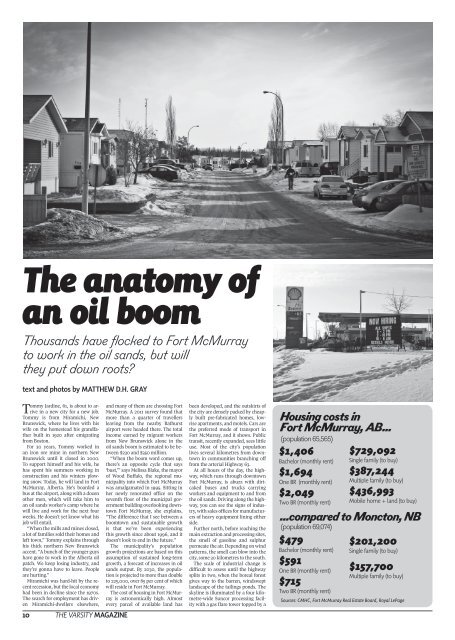Create successful ePaper yourself
Turn your PDF publications into a flip-book with our unique Google optimized e-Paper software.
<strong>The</strong> anatomy of<br />
an oil boom<br />
Thousands have flocked to Fort McMurray<br />
to work in the oil sands, but will<br />
they put down roots?<br />
text and photos by MATTHEW D.H. GRAY<br />
Tommy Jardine, 61, is about to arrive<br />
in a new city for a new job.<br />
Tommy is from Miramichi, New<br />
Brunswick, where he lives with his<br />
wife on the homestead his grandfather<br />
built in 1920 after emigrating<br />
from Boston.<br />
For 30 years, Tommy worked in<br />
an iron ore mine in northern New<br />
Brunswick until it closed in 2000.<br />
To support himself and his wife, he<br />
has spent his summers working in<br />
construction and his winters plowing<br />
snow. Today, he will land in Fort<br />
McMurray, Alberta. He’s boarded a<br />
bus at the airport, along with a dozen<br />
other men, which will take him to<br />
an oil sands worker’s camp where he<br />
will live and work for the next four<br />
weeks. He doesn’t yet know what his<br />
job will entail.<br />
“When the mills and mines closed,<br />
a lot of families sold their homes and<br />
left town,” Tommy explains through<br />
his thick northern New Brunswick<br />
accent. “A bunch of the younger guys<br />
have gone to work in the Alberta oil<br />
patch. We keep losing industry, and<br />
they’re gonna have to leave. People<br />
are hurting.”<br />
Miramichi was hard-hit by the recent<br />
recession, but the local economy<br />
had been in decline since the 1970s.<br />
<strong>The</strong> search for employment has driven<br />
Miramichi-dwellers elsewhere,<br />
10 the VARSItY magazine<br />
and many of them are choosing Fort<br />
McMurray. A 2011 survey found that<br />
more than a quarter of travellers<br />
leaving from the nearby Bathurst<br />
airport were headed there. <strong>The</strong> total<br />
income earned by migrant workers<br />
from New Brunswick alone in the<br />
oil sands boom is estimated to be between<br />
$230 and $350 million.<br />
“When the boom word comes up,<br />
there’s an opposite cycle that says<br />
‘bust,’” says Melissa Blake, the mayor<br />
of Wood Buffalo, the regional municipality<br />
into which Fort McMurray<br />
was amalgamated in 1995. Sitting in<br />
her newly renovated office on the<br />
seventh floor of the municipal government<br />
building overlooking downtown<br />
Fort McMurray, she explains,<br />
“<strong>The</strong> difference that I see between a<br />
boomtown and sustainable growth<br />
is that we’ve been experiencing<br />
this growth since about 1996, and it<br />
doesn’t look to end in the future.”<br />
<strong>The</strong> municipality’s population<br />
growth projections are based on this<br />
assumption of sustained long-term<br />
growth, a forecast of increases in oil<br />
sands output. By 2030, the population<br />
is projected to more than double<br />
to 225,000, over 85 per cent of which<br />
will reside in Fort McMurray.<br />
<strong>The</strong> cost of housing in Fort McMurray<br />
is astronomically high. Almost<br />
every parcel of available land has<br />
been developed, and the outskirts of<br />
the city are densely packed by cheaply<br />
built pre-fabricated homes, lowrise<br />
apartments, and motels. Cars are<br />
the preferred mode of transport in<br />
Fort McMurray, and it shows. Public<br />
transit, recently expanded, sees little<br />
use. Most of the city’s population<br />
lives several kilometres from downtown<br />
in communities branching off<br />
from the arterial Highway 63.<br />
At all hours of the day, the highway,<br />
which runs through downtown<br />
Fort McMurray, is abuzz with dirtcaked<br />
buses and trucks carrying<br />
workers and equipment to and from<br />
the oil sands. Driving along the highway,<br />
you can see the signs of industry,<br />
with sales offices for manufacturers<br />
of heavy equipment lining either<br />
side.<br />
Further north, before reaching the<br />
main extraction and processing sites,<br />
the smell of gasoline and sulphur<br />
permeate the air. Depending on wind<br />
patterns, the smell can blow into the<br />
city, some 30 kilometres to the south.<br />
<strong>The</strong> scale of industrial change is<br />
difficult to assess until the highway<br />
splits in two, when the boreal forest<br />
gives way to the barren, windswept<br />
landscape of the tailings ponds. <strong>The</strong><br />
skyline is illuminated by a four kilometre-wide<br />
Suncor processing facility<br />
with a gas flare tower topped by a<br />
Housing costs in<br />
Fort McMurray, AB...<br />
(population 65,565)<br />
$1,406<br />
Bachelor (monthly rent)<br />
$1,694<br />
One BR (monthly rent)<br />
$2,049<br />
Two BR (monthly rent)<br />
$479<br />
Bachelor (monthly rent)<br />
$591<br />
One BR (monthly rent)<br />
$715<br />
Two BR (monthly rent)<br />
$729,092<br />
Single family (to buy)<br />
$387,244<br />
Multiple family (to buy)<br />
$436,993<br />
Mobile home + land (to buy)<br />
...compared to Moncton, NB<br />
(population 69,074)<br />
$201,200<br />
Single family (to buy)<br />
$157,700<br />
Multiple family (to buy)<br />
Sources: CMHC, Fort McMurray Real Estate Board, Royal LePage


